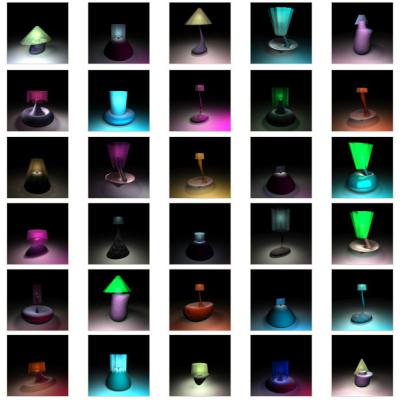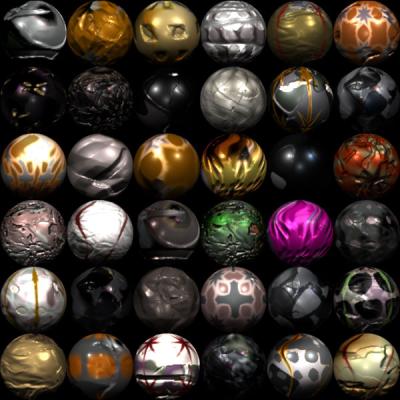Interactive Evolutionary Design
Summary
This software uses qualitative information to select and recombine designs, producing a new generation of design solutions.
Project Team
Students:
Jonathan Eisenmann, Computer Science
Bryan Cline, Computer Science
Boris Bezirtzis, Design
Cara Christeson, Design
Keith Ruston, Computer Science
Faculty Researcher:
Matthew Lewis, ACCAD
Project Description
Interactive evolutionary design systems allow individuals to explore design solutions that might never have been considered using more traditional means. The first approach involves the "meta-design" of a parametric prototype which implicitly defines an immense set of possible designs. The computer initially presents the user with a randomly generated population of these designs. The user chooses the "best" ones based purely on subjective, personal evaluation criteria. The software uses this qualitative "fitness" information to select which designs will be recombined ("mated" and "mutated") to produce the next generation of new design solutions. This process can be repeated until the user converges on a satisfactory set of solutions.
Such systems are investigated by building them using existing digital content creation software such as Maya, Max/MSP/Jitter, Houdini, and RenderMan. While the great majority of interactive evolutionary design research systems have involved entirely custom software intended for breeding entities within one fairly narrow problem domain, e.g., certain classes of buildings, cars, images, etc. Current focus is the creation of generic tools within these environments to allow non-programmers who are familiar with these tools to create their own evolutionary design problem spaces within the scope of each software package (e.g. exploring 3D form, lighting, or motion with Maya, or real-time video filtering within Jitter.)
References
- J. Eisenmann, M. Lewis, and R. Parent “Probabilistic Decision Making for Interactive Evolution with Sensitivity Analysis”. In Proceedings of EvoStar: EvoMUSART, Malaga, Spain, Apr. 2014.
- J. Eisenmann, M. Lewis, and R. Parent “Trace Selection for Interactive Evolutionary Algorithms”. In Proceedings of SigEVO: GECCO, Amsterdam, The Netherlands, Jul. 2013.
- J. Eisenmann, M. Lewis, and R. Parent “Inverse Mapping with Sensitivity Analysis for Partial Selection in Interactive Evolution”. In Proceedings of EvoStar: EvoMUSART, Vienna, Austria, Apr. 2013.
- Eisenmann, Jonathan, Benjamin Schroeder, Matthew Lewis, and Rick Parent, "Creating Choreography with Interactive Evolutionary Algorithms" EvoApplications: EvoMUSART, Turin, Italy, April 2011
- Eisenmann, Jonathan, Matthew Lewis, and Bryan Cline, “Interactive Evolutionary Design for Motion Variants” International Conference on Evolutionary Computation, IJCCI, Madeira, Portugal, October 2009
- Lewis, Matthew R. "Casually Evolving Creative Technology Systems" in Computational Creativity: An Interdisciplinary Approach, Margaret Boden, Mark D'Inverno, and Jon McCormack, editors. Dagstuhl Seminar Proceedings 09291, Schloss Dagstuhl, Germany, 2009.
- Bezirtzis, Boris, Matthew Lewis, and Cara Christeson, "Interactive evolution for industrial design" Proceedings of the 6th ACM SIGCHI Conference on Creativity & Cognition, New York, NY, 2007
- Lewis, Matthew and Keith Ruston. “Aesthetic Geometry Evolution in a Generic Interface Evolutionary Design Framework” in New Generation Computing 23(2005), Ohmsha, Ltd. and Springer, 2005.
- Lewis, Matthew. “Aesthetic Video Filter Evolution in an Interactive Real-time Framework” in Applications of Evolutionary Computing, EvoWorkshops 2004, Coimbra, Portugal, 2004.
- Lewis, Matthew and Richard Parent. “Interactively Evolving Virtual Environment Maps with Continuous Layered Pattern Functions” in Proceedings of the 15th International Conference on Computer Animation, Geneva, Switzerland, June 19-21, 2002.
- Lewis, Matthew. Creating Continuous Design Spaces for Interactive Genetic Algorithms with Layered, Correlated, Pattern Functions. Ph.D. Thesis. Ohio State University, 2001.
- Lewis, Matthew. “Aesthetic Evolutionary Design with Data Flow Networks” in Proceedings of Generative Arts 2000, Milan, Italy, ed. Celestino Soddu, December, 2000.
- Lewis, Matthew. “An Implicit Surface Prototype for Evolving Human Figure Geometry” OSU-ACCAD- 11/ 00-TR2, Advanced Computing Center for the Arts and Design, The Ohio State University, 2000.
Completed in 2014.




